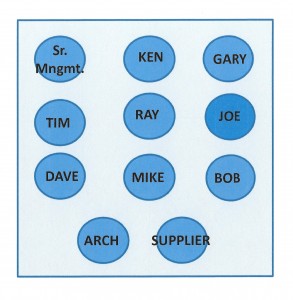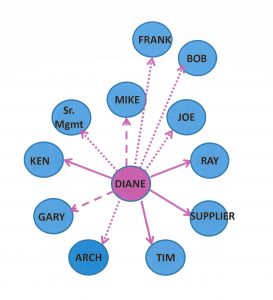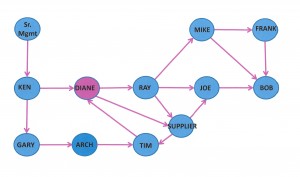From Blue to Purple
A woman who leads her workplace away from Autonomy and into the Purple Zone will be successful.Autonomy Reigns Supreme
The first thing any woman working in the male-dominated workplace needs to know is that Autonomy is the most important male trait. It drives and defines the male-dominated workplace and the Blue Zone.

Autonomy Empowers Men
Autonomy empowers men as individuals. It declares they are adults who have an inherent right to self-determination. It says they are fully empowered to do what they want, how they want, when they want. Autonomy gives men their great sense of self, their confidence and the power to stand up for themselves.
In the workplace if Autonomy is left uncontrolled it leads to chaos as all of our male colleagues do what they want, how they want, when they want. In order to control or limit men’s Autonomy requires writing and enforcing policies, rules or laws. These restrictions typically don’t sit well with men because they interpret limiting their Autonomy as meaning they are less capable. They equate it to treating them more like a child who must be told what to do and how to do it instead of a fully capable adult. So when a new restriction is put in place, expect men to rebel or ignore it.
Autonomy is also at the core of our belief in the power of the individual man to make things happen and get things done. It promotes our idea of the self-made man who overcomes all odds, obstacles and challenges to succeed. Our ultimate autonomous man needs nothing more than his belief in himself and his abilities to become a great Hero.
For thousands of years societies relied on the autonomous men who’s great achievements fill history books. Autonomy gives us our heroes, leaders, MVP’s, Alpha’s, victors, inventors, adventurers and conquerors.
It wasn’t until the advent of the industrial revolution that Complexity began to emerge and diminish the power of Autonomy. Today, Complexity has rendered Autonomy pretty much powerless. However, our Blue Zone male-dominated workplace refuses to believe it. It still turns to Autonomy and the power of the individual man for solutions and to make great things happen.
Our continued belief in the omnipotent power of Autonomy is the core source of just about every problem in our workplaces and society. It is the core problem I spent my entire career correcting.
When I began my career I was surprised at all of the chaos. All of my male colleagues were busy, off doing stuff, but I couldn’t pinpoint exactly what they were accomplishing. They were scattered about, each man in his own world, doing his own thing, his own way. There was no coordination, integration or follow-up. The result was inefficiency, chaos, stress and crisis management. Even though I asked every man to please explain how they could function this way, no one could.
They simply didn’t understand any other way of working.
What I was witnessing was too much Autonomy. Every single one of my male-dominated workplaces shared this problem, with some being far worse than others.
Most of us don’t recognize Autonomy in the male-dominated workplace because we are taught the male-dominated workplace functions through survival of the fittest as men strive to have power over each other. This is far from the truth.
The Blue Zone Hero
The following scenario illustrates how the Blue Zone relies on Autonomy and it’s all-important hero to get things done. I’ve experienced and corrected similar scenarios more times than I can count. And if you think about it, similar scenarios happen every day in your workplace too.
- Mike tasks Bob to build a wall starting on the 25th.
- Bob sends his crew to move the wall material to the job site from the material storage area.
- Bob’s crew reports back that they can’t find the material
- Bob talks to Joe who manages the material storage area. Joe says the material hasn’t been delivered and Bob needs to check with Ray who orders the material.
- Ray tells Bob that the material was ordered but Timber Suppliers hasn’t given a delivery date yet.
- Ray and Bob call Timber Suppliers and the rep says he told Dave who wrote the Purchase Order that the material had to be ordered by the 5th to arrive on time. It wasn’t ordered until the 10th.
- Ray says he didn’t know the material had to be ordered by the 5th and he ordered the material as soon as he got the Purchase Order from Dave.
- Bob calls Dave who says the material had to be approved by Tim before he could write the Purchase Order.
- Tim says the wall material was changed from what was originally specified and had to go the architect for approval. Tim says if there are issues with the architects then Bob needs to talk to Gary.
- Gary tells Bob the architects were very busy and wanted more money to expedite review of the new material. It took two weeks to get their change order approved. He doesn’t know why senior management directed the change in the wall material and Bob needs to talk to Ken to find out why.
- According to Ken, senior management is pressuring to cut costs and the change saves $15,000. He says senior management made the decision and since he doesn’t attend their meetings he had no input into the decision.

It may seem like each guy is passing the buck to someone else but the real issue is that everyone is working autonomously in a complex situation which creates a lack of accountability.
Everyone did their job and no one can say they didn’t. But the complexity of the project allows each person to point their finger(s) at someone else and say “Its not my fault.” With fingers pointing in all directions, there is either no one or everyone to blame.
The real problem is that no one was looking at and working the big picture. No one was managing how all the tasks had to come together in order to start the wall on time. We often believe that this is a manager’s or supervisor’s job but they are often too busy with their own autonomous tasks to follow-up and coordinate work with their staff. Autonomy lets management off the hook too.
Right now this workplace has a major crisis – the wall can’t be built because there is no material. Working from the Blue Zone, it will look for a solution based in Autonomy. It will look to the power of the individual to step forward and rescue everyone from this crisis.
 It looks to Mike.
It looks to Mike.
Mike has been through this before and knows what to do. He has an excellent relationship with another material supplier Champion Supplies and he calls in a favor. He can get the originally specified material delivered the next morning. Mike places the order. The material is delivered so Bob can build the wall.
Mike made it happen. He was decisive, confident, respected, he knows his stuff and he doesn’t let anything stand in his way. He is everything the Blue Zone values. Mike is the workplace Hero who saved yet another day!
Everyone breathes a collective sigh of relief.

Complexity rolls her eyes and shakes her head as she says “Not so fast guys. I don’t care how powerful you think your Blue Zone hero is. He can’t dominate me!”
Then to prove her point, Complexity unleashes a wrath of unintended consequences:
- The change back to the original material not only negates the $15,000 in savings senior management was counting on, there is an additional $8,000 fee for the expedited delivery from Champion Supplies.
- When Mike placed the order with Champion Supplies he busted the workplace’s credit limit. Now no one else can order material from them until some invoices are paid. Other projects are mad and yelling at the nice ladies in Accounts Payable. However, the ladies can’t pay Champion Supplies because they don’t have any invoices. They call up Champion Supplies who stops what they are doing to generate and email the invoices. The Accounts Payable ladies request a special check run so they can FedEx the check to Champion Supplies that afternoon. After all the stress and disruption, the Accounts Payable ladies demand to know who is buying them chocolate.
- Timber Suppliers wants a restocking fee of $10,000 for the material that is in route.
- Tim has to get a new submittal package from Champion Supplies and get it approved. Hopefully the submittal package can be approved before anyone notices the wall material was changed again and stops construction.
- Gary has to get another change order for the architects to review this submittal and they will be really mad because they rushed the review of the previous submittal and it wasn’t even used.
- Dave has to write a new Purchase Order to Champion Supplies and Ken has to explain to senior management why they won’t get their $15,000 savings. His stomach hurts from the dread of the impending management blowup when he also says there is a $10,000 restocking fee and $8,000 expedited delivery fee.
- Everyone needs a scapegoat to avoid the finger of Blame being pointed at them. Champion Supplies suggests it is all the fault of his competitor Timber Suppliers. Since Timber Suppliers is a seldom used vendor, everyone jumps on band wagon of blaming them. Senior management bans the workplace from using Timber Suppliers in the future and demands they pay the $23,000 in additional costs and refuses to pay the $10,000 restocking fee. A long legal battle starts that wastes hundreds of man-hours and thousands of dollars. Years later Timber Suppliers prevails but the project is long complete so everyone can sweep the loss under the rug and not be tainted by it.
While this is a long list of unintended, disruptive and costly consequences, there is one more. And it’s the real kicker!
As it turns out, Bob couldn’t start building the wall on the 25th anyway.
Frank wasn’t done with the concrete foundation. But no one knew that because no one talked to Frank.
So, all of the crises, expense, stress and drama was for nothing.
And it all could have been prevented if Autonomy was ended.
This is why the male-dominated workplace desperately needs women.
Creating Purple
As women we should never go into the Blue Zone and dive into Autonomy by pulling up the walls of our cubicle and turning up the music in our headphones so we can turn a blind eye to all the problems swirling around us. If we do, we miss our calling.
The male-dominated workplace gives us the opportunity to end Autonomy by working with and managing Complexity. While she hates autonomous men, she likes us. Complexity is our BFF and greatest ally. She knows that when we assert our characteristics, we have the power to transform male-dominated workplace.
Complexity knows women are natural big picture managers, coordinators and integrators – skills desperately missing in the male-dominated workplace.

When women read through the wall building scenario our reaction is “Come on guys – work together! Communicate!” This is because our characteristics do the opposite of Autonomy – they connect people, tasks and information. 
If we replace one man with a woman we can change everything. So let’s replace Dave who writes the Purchase Order with Diane.
Diane understands her relationship to each of her male colleagues. The solid line represents her primary relationships – the men she works with directly. The dashed line represents her secondary relationships – the men she knows influence her work and who she influences. The dotted line represents her tertiary relationships – the men she is the most removed from but still a fellow team member.
Because Diane is connected to each of the men, she hears and pays attention to what is going on. She hears Ken say that the wall material got changed. She knows this will impact their work and everyone has to respond. There could be a time crunch. Her emotional radar is going off and she thinks – What do we have to do?
If she is in the Blue Zone she ignores her emotional radar that is hinting there could be a big problem brewing. She knows she can pull up the walls of her cubicle and hide in Autonomy. After all, she’s not the boss; it’s not her job and not her responsibility.
But if she is in the Purple Zone, she starts talking to her male colleagues. She calls Timber Suppliers and learns the delivery timeline is long. She lets Gary know so he can rush the architects. She makes several other phone calls to help move the process along.
Diane is working the process and trying to manage the big picture but she finds it takes a lot of time to coordinate her autonomous colleagues. She knows she is working inefficiently which is against the Lean principles her company espouses.
She also feels like she is doing a lot of hand-holding. Her male colleagues should be working the process too. But they don’t understand the big picture so they don’t have the right sense of urgency.
Diane decides to do something bold – she is going to assert her female leadership. She calls a meeting so together they can map out how to manage the material change. The meeting only takes 30 minutes. 
It gives everyone a new perspective.
They monitor where they are on getting the material delivered against where Frank is on finishing the foundation. Mike helps Frank get the concrete done on time.
They get the change order for the architects expedited and help the architects reprioritize their work.
They talk to Timber Suppliers and find out that if they split the order into two deliveries, they will get the first delivery 5 days faster and the split won’t impact the wall construction schedule.
Bob begins the wall on the 25th as scheduled. Frank finishes his foundation work on the 26th with minimal impact on Bob. The workplace saves $15,000 and senior management is happy because the bonus pool is funded.
Once they go through the process and avoid all the stress and frustration, they want to apply the same concept again to eliminate other problems. Diane gladly leads them through the effort again.
Diane keeps reinforcing their new procedures. She says things like – “No Ray. You can’t order the material yet because Tim hasn’t approved it.” Or, “Ken, you need to run that through Gary and the architects before I can write the purchase order.” Her male colleagues back her up because they don’t want the stress and frustrations to return.
With Diane’s continuous reinforcing the workplace operates in the Purple Zone.
Performance increases and that attracts management attention. Management wants to know what they are doing differently. Diane shes her opportunity and seizes it – she can articulate what they are doing better than the men because she is the only one who understands Pink Zone characteristics and how to create the Purple Zone.
Management doesn’t quite get it but they like the results. Eventually Diane gets a promotion and starts breaking through barriers as she continues to lead her workplace to the Purple Zone.

The great workplaces will be the ones that fully understand how to empower female traits so they can work in wholeness. They will be the ones that achieve and sustain an unprecedented level of spectacular results. They will be the industry leaders in the 21st century.
